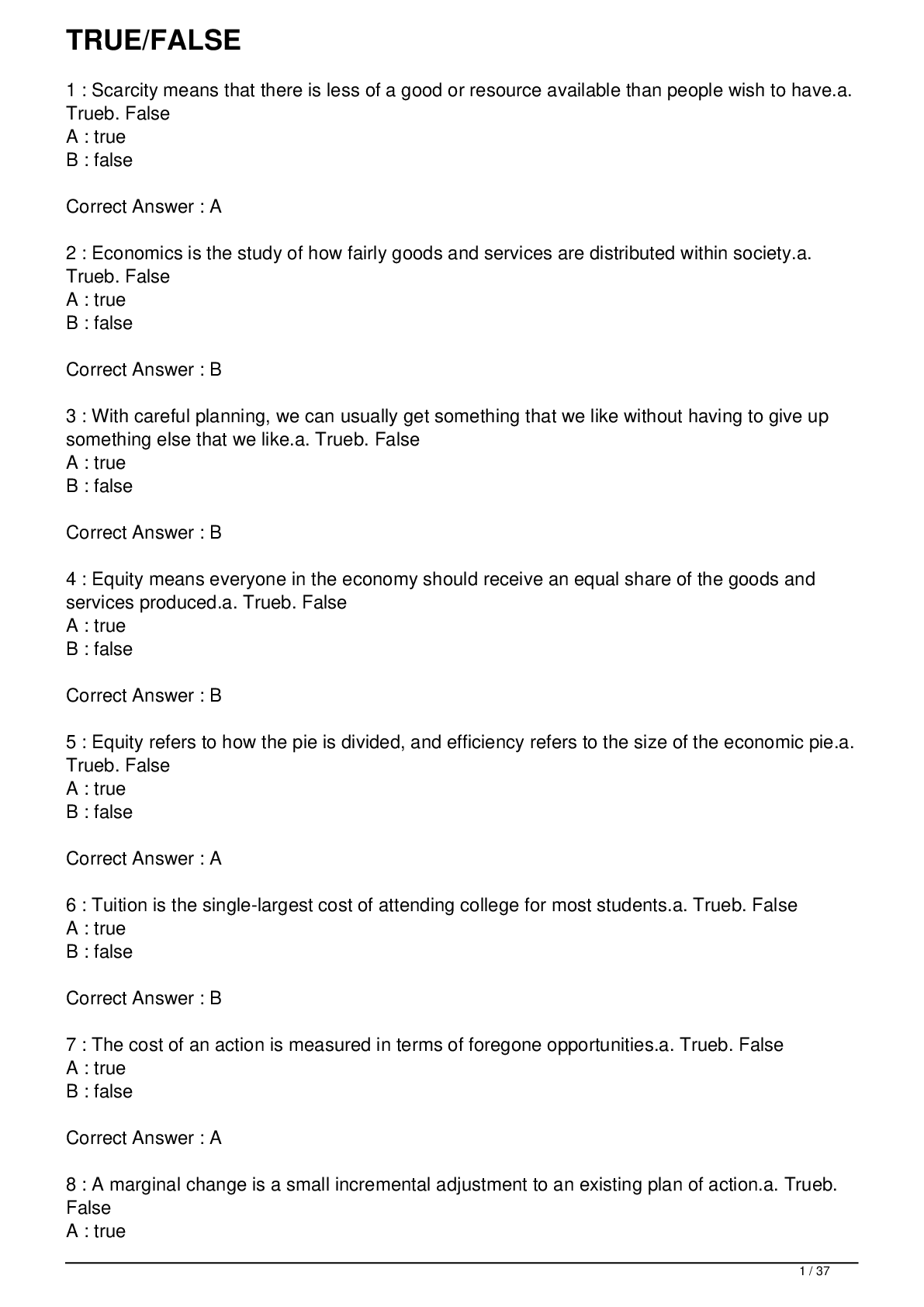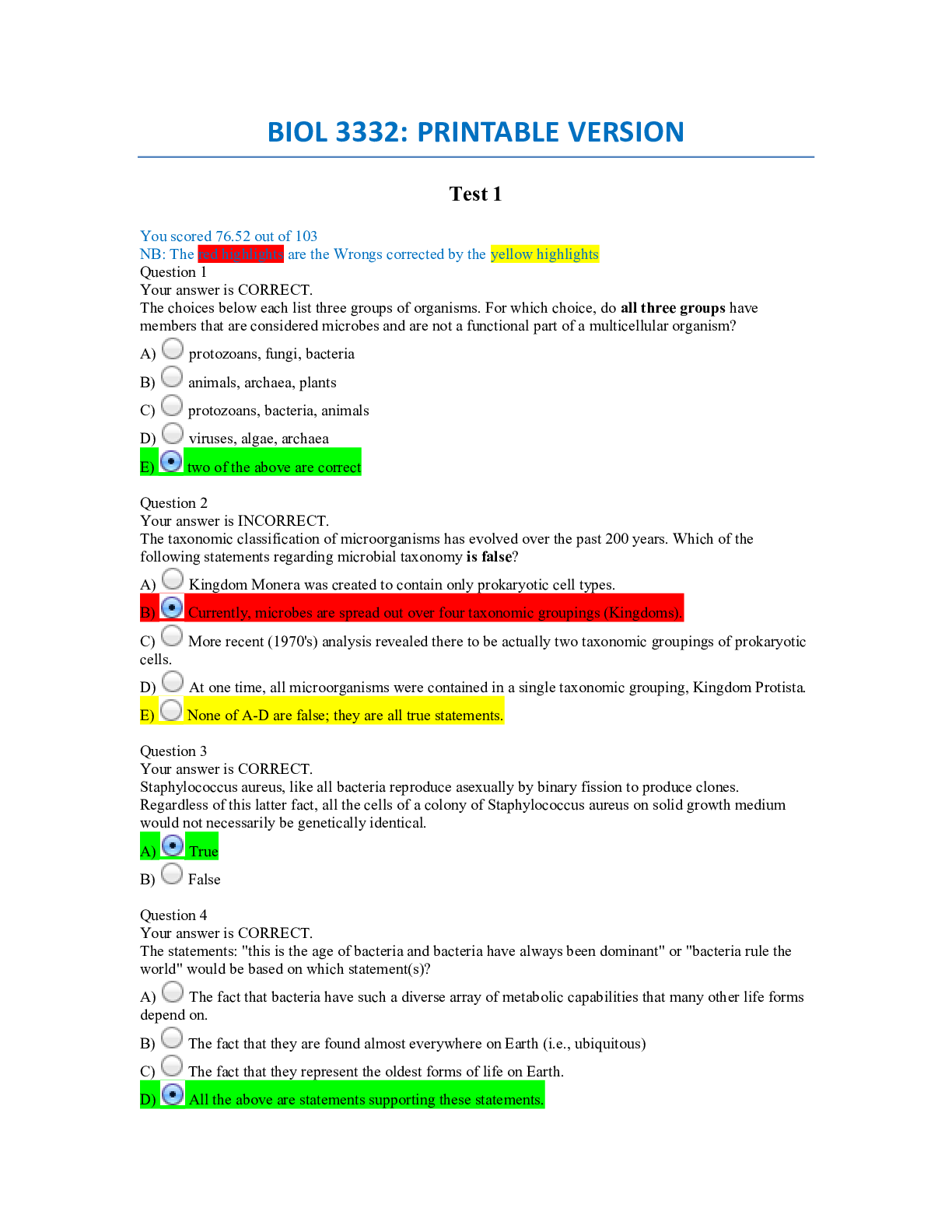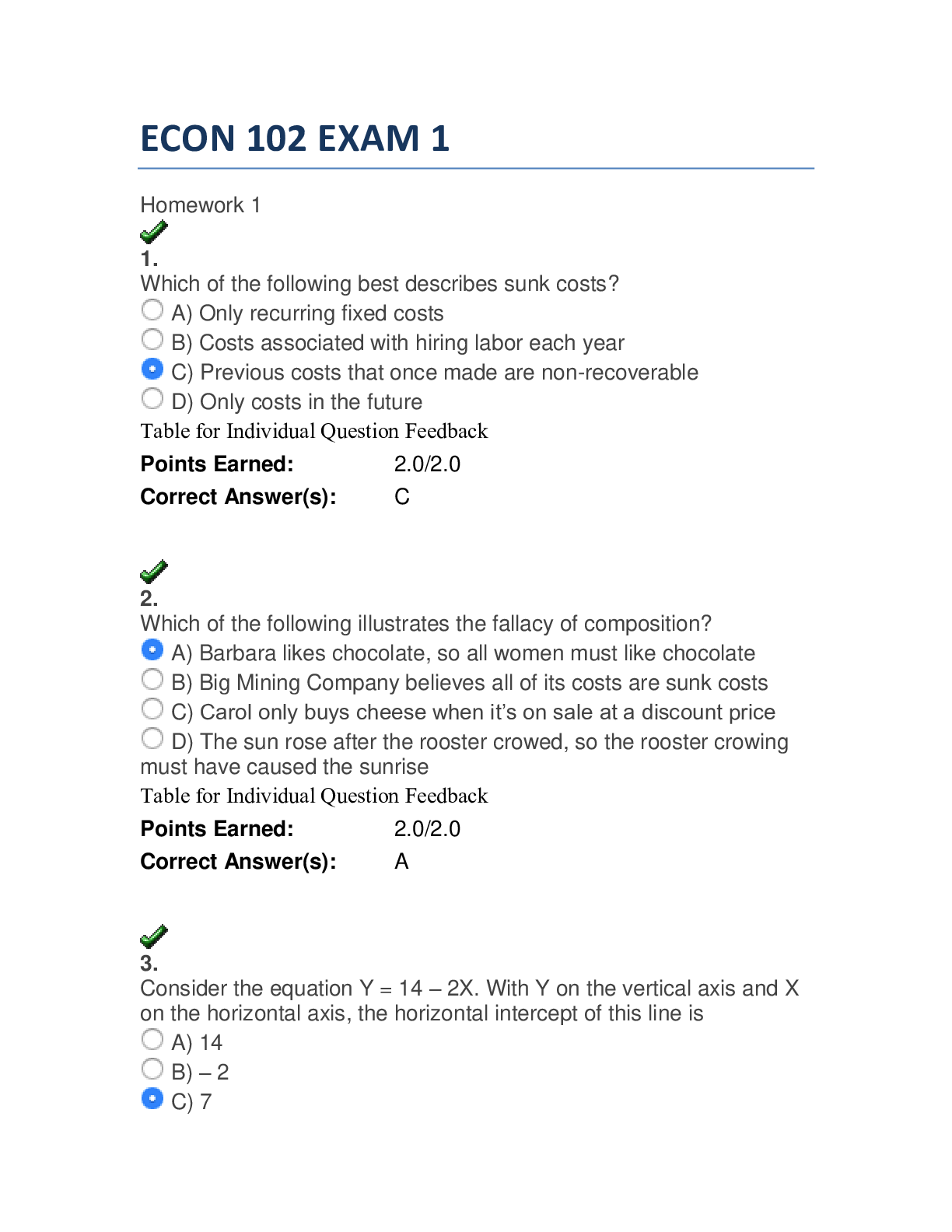*NURSING > EXAM > MED SURG 2 EXAM 1 - Comprehensive review Medical Surgical Nursing II Exam 2021 (All)
MED SURG 2 EXAM 1 - Comprehensive review Medical Surgical Nursing II Exam 2021
Document Content and Description Below
Ch. 25 – ASSESSMENT OF CARDIOVASCULAR FUNCTION Conduction System • Automaticity = ability to initiate an electrical impulse • Excitability = ability to respond to an electrical impulse • C... onductivity = ability to transmit an electrical impulse from one cell to another SA node à AV node à bundle of his à right bundle branch à left bundle branch à purkinje fibers *SA node is the primary pacemaker of the heart Depolarization: electrical activation of cell caused by influx of sodium into cell while potassium exits cell Repolarization: return of cell to resting state caused by re-entry of potassium into cell while sodium exits Refractory periods ► Effective refractory period: phase in which cells are incapable of depolarizing ► Relative refractory period: phase in which cells require stronger-than-normal stimulus to depolarize Cardiac Action Potential Phases (won’t ask but understand) Phase 0 = Na comes into the actual cell (RAPID depolarization, SODIUM IN) Phase 1 = early cell repolarization – K+ coming out of the cell (POTASSIUM OUT) Phase 2 = plateau phase (rate of repolarization slows); Ca+ ENTER CELL Phase 3 = complete repolarization (return of cell to resting state) Phase 4 = resting phase before the next depolarization Aorta has the highest pressure (biggest) high force…pressure in left ventricle + aorta highest pressure is higher pressure in the cardiac system ** Majority of MI occurs in left ventricle! CO = HR x SV Cardiac output = total amt. of blood ejected by one of the ventricles in L/min (in resting adult about 4-6 L/min)lOMoAR cPSD|5967629 Downloaded by IAN NJUGUNA (iannjuguna47@gmail.com) Stroke volume = amount of blood ejected from one of the ventricles per heartbeat (average = 60-130 mL) Changes in HR are due to inhibition or stimulation of the SA node by the parasympathetic and sympathetic divisions. PNS travels to SA node through vagus nerve à vagal stimulation = slows the HRlOMoAR cPSD|5967629 Downloaded by IAN NJUGUNA (iannjuguna47@gmail.com) SNS increases HR by innervation of the beta-1 receptors located within SA node (occurs through an increase in circulation catecholamines (secreted by the adrenal gland) and by excess thyroid hormone, which produces a catecholamine-like effect HR also affected by CNS and baroreceptor activity (sensitive to changes in BP) à when BP is high – baroreceptors stimulate PNS activity, lowering HR. When BP is low à they stimulate SNS activity, raising HR. SV is determined by preload, afterload, and contractility. Preload = how much blood is within the ventricle before you pump it out (at the end of diastole right before systole occurs) Afterload = the resistance of ejection of blood from the ventricle Contractility = the force generated by the contracting myocardium Women usually develop CAD 10 years later than men b/c they benefit from female hormone estrogen and its cardioprotective effects 1. Increase in HDL (transports cholesterol out of arteries 2. Reduction in LDL (deposits cholesterol in the artery) 3. Dilation of the blood vessels (enhances blood flow to the heart) *post-menopausal women = higher risk of CAD b/c estrogen levels slowly disappear COMMON SYMPTOMS of CVD ► Chest pain ► Dyspnea ► Peripheral edema, weight gain, abdominal distention ► Palpitations ► Fatigue ► Dizziness, syncope, changes in level of consciousness Chest pain – identify quantity (0-10), location, and quality. Radiation of pain? Associated S/S like sweating or nausea; duration? Assess for other cardiac conditions; assess for other significant conditions ► Pneumonia, pulmonary embolism ► Hiatal hernia, GERD ► Costochondritis ► Vascular “Costochondritis – inflammation process in the cartilage (pain can be so severe that they think they’re having a heart attack); TX would be rest… would still do an EKG” ASSESSMENT: ► Medications – aspirin = common OTC med that improves outcomes in CAD pts ► Nutrition – nut. risk factors = hyperlipidemia, HTN, diabetes ► Height + weight ► BMI ** (assessment for obesity) ► Lab results – glucose, glycosylated Hb (diabetes), cholesterol, HDL, LDL, triglyceride levelslOMoAR cPSD|5967629 Downloaded by IAN NJUGUNA (iannjuguna47@gmail.com) ► Diet & eating habits (commercially prepared foods, high-sodium, etc) ► Elimination – nocturia = common in pts with HF ** ► Screen for bloody urine or stools in pts taking platelet-inhibiting meds (ex. aspirin, Plavix; platelet aggregation inhibitors, or anticoagulants (ex. heparin, warfarin (Coumadin), Lovenox, etc. ► Activity, exercise – activity-induced angina or SOB may indicate CAD ► Sleep, rest: ► orthopnea (need to sit upright or stand to avoid feeling SOB) often occurs in pts with worsening HF ► paroxysmal nocturnal dyspnea – sudden awakening with SOB = another symptom of worsening HF ► Self-perception/concept – quit smoking (to reduce risk of future CV probs) ► Roles, relationships – assess the pts support system (esp. bc many invasive cardiac procedures like cardiac catheterization and percutaneous coronary intervention (PCI) are being performed as outpatient procedures! ► Sexuality, reproduction – impotence may develop in men as a side effect of cardiac meds (ex. beta blockers) – may cause some men to stop taking it! ► Coping, stress tolerance ► high levels of anxiety are assoc. with increased incidence of CAD ► pts with CAD and HF should be assessed for depression (pts with score of 3 or higher should be referred for further eval.) ► social readjustment rating scale – widely used tool to measure life stress ► pts with a score less than 150 = slight risk for future illness ► score of 150-299 = moderate risk PHYSICAL ASSESSMENT (Any deviations from the normal?) ► Heart as a pump à reduced pulse pressure, displaced PMI from 5th ICS midclavicular line, gallop sounds, murmurs ► Atrial/ventricular filling volumes à JVD, peripheral edema, ascites, crackles, postural BP changes ► Cardiac output à reduced pulse pressure, hypotension, tachycardia, reduced urine output, lethargy, disorientation ► Compensatory mechanisms à peripheral vasoconstriction, tachycardia “Best diagnostic tool – echocardiogram (DX choice to pick up a regurgitation or stenosis)” CARDIAC-SPECIFIC ► General appearance – changes to LOC, BMI > 30 ► Assessment of skin/extremities ► S/S of acute obstruction of arterial blood flow in extremities = “6 P’s”= Pain, pallor, pulselessness, paresthesia, poikilothermia (coldness), paralysis ► Should be assessed during the first few hours after invasive cardiac procedures like cardiac catheterization, PCI, or cardiac electrophysiology testing ► Hematoma ► Edema (peripheral edema = feet, ankles, or legs à common in HF or PVDs like DVT or chronic venous insufficiency) or pitting edema ► Prolonged capillary refilllOMoAR cPSD|5967629 Downloaded by IAN NJUGUNA (iannjuguna47@gmail.com) ► BP ► Clubbing of fingers and toes ► Hair loss, brittle nails, dry scaly skin ► Pulse pressure = systolic – diastolic! ➔ normally 30-40 ► decreased pulse pressure reflects reduced SV and ejection velocity (shock, HF, hypovolemia, mitral regurgitation) or obstruction to bloow flow during systole (mitral or aortic stenosis) ► pulse pressure < 30 = serious reduction in CO!! ► Postural blood pressure changes à postural/ orthostatic hypotension in pts with CVD most often due to sig. reduction in preload, which compromises CO. TAKE BP LAYING, SITTING, STANDING! ► Arterial pulses ► Pulse rate ► Pulse rhythm ► Pulse amplitude – absent, diminished, normal, bounding ► If pulse is absent or hard to palpate = doppler ► Jugular venous distention à right-sided heart failure, fluid overload ► Heart inspection/palpation ► Heart auscultation ► Normal heart sounds = S1, S2 (AV closure, semilunar closure) ► Abnormal heart sounds = S3, S4 ► Assessment of lungs à ► hemoptysis à pink/frothy = pulmonary edema ► cough, crackles, wheezes ► Assessment of abdomen à distention = ascites, hepatojugular reflex = positive test confirms DX of HF, bladder distention = urine output is an important indication of cardiac fxn *right sided heart failure = ASCITES, HEPATOJUGULAR REFLEX, DISTENTION “MR. ASS” (systolic) & “MS. ARD” (diastolic) ➔ (ACRONYM) Mitral regurgitation and atrial stenosis = systolic murmurs Mitral stenosis and aortic regurgitation = diastolic murmurs (not good sign*) [Show More]
Last updated: 2 years ago
Preview 1 out of 46 pages
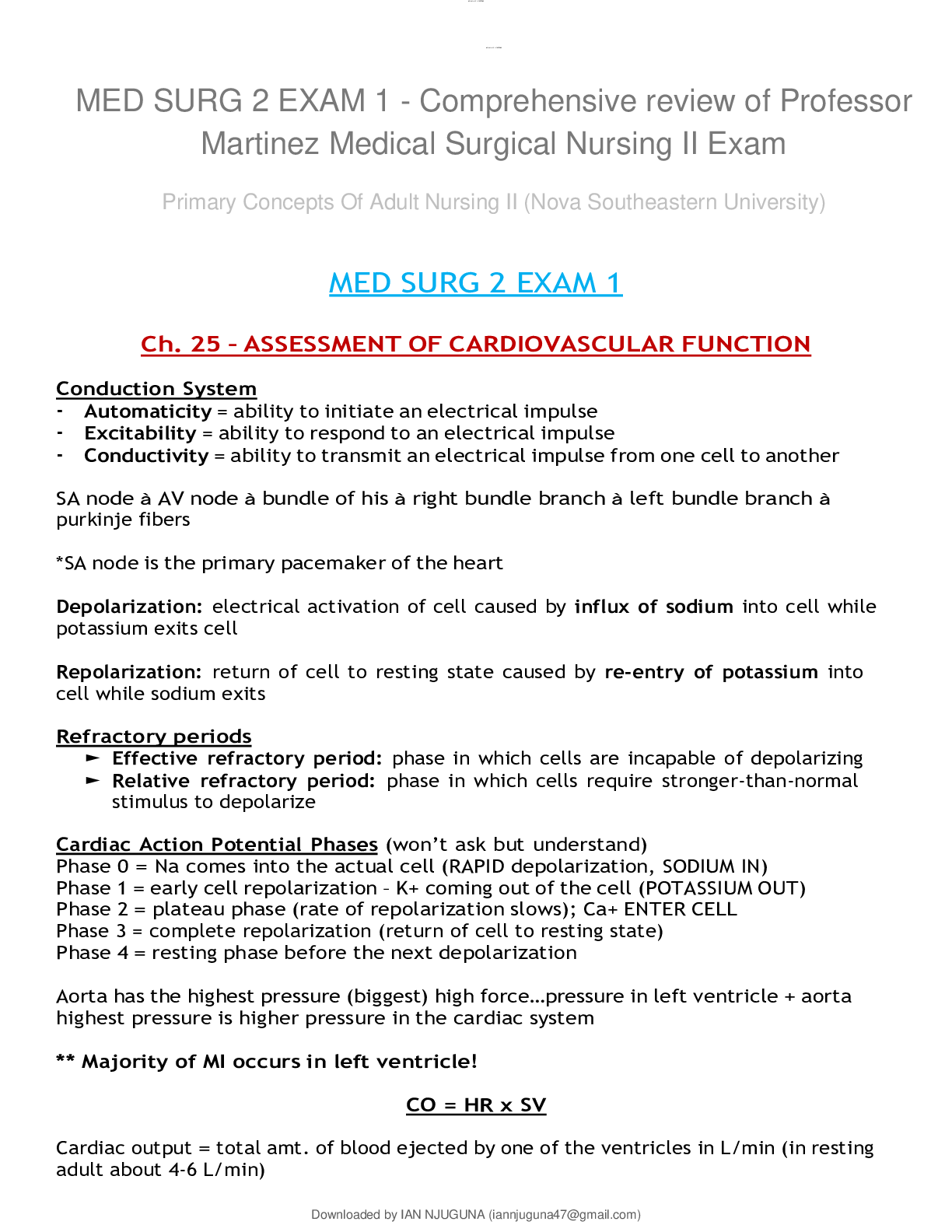
Buy this document to get the full access instantly
Instant Download Access after purchase
Buy NowInstant download
We Accept:

Reviews( 0 )
$10.00
Can't find what you want? Try our AI powered Search
Document information
Connected school, study & course
About the document
Uploaded On
Aug 13, 2021
Number of pages
46
Written in
Additional information
This document has been written for:
Uploaded
Aug 13, 2021
Downloads
0
Views
89




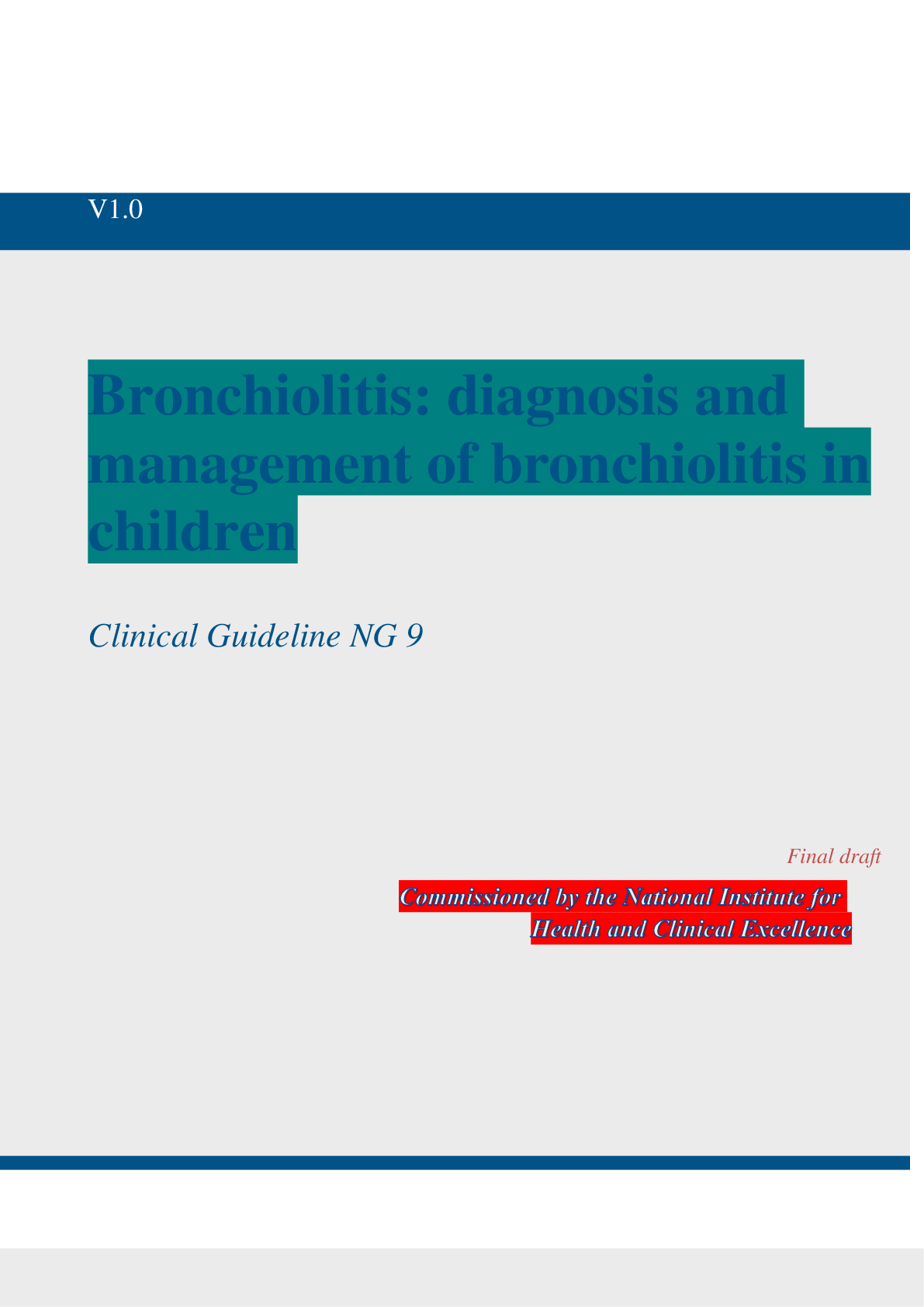


.png)

